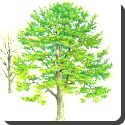 Beech European — The European Beech or Common Beech (Fagus sylvatica) is a deciduous tree belonging to the beech family Fagaceae.
Beech European — The European Beech or Common Beech (Fagus sylvatica) is a deciduous tree belonging to the beech family Fagaceae.
The natural range extends from southern Sweden (with some isolated locations in southern Norway) to central Italy, west to France, northern Portugal, and central Spain, and east to northwest Turkey, where it intergrades with the Oriental Beech (F. orientalis), which replaces it further east. In the Balkans, it shows some hybridisation with Oriental Beech; these hybrid trees are named Fagus x taurica. In the southern part of its range around the Mediterranean, it grows only in mountain forests, at 600-1,800 m altitude. Although often regarded as native in southern England, recent evidence suggests that it did not arrive in England until about 4,000 BC, or 2,000 years after the English Channel formed after the ice ages; it could have been an early introduction by Stone age man, who used the nuts for food.
It is a large tree, capable of reaching heights of up to 48 m tall and 3m trunk diameter, though more typically 25-35 m tall and up to 1.5 m trunk diameter. It has a typical lifespan of 150 to 200 years, though sometimes up to 300 years. The appearance varies according to its habitat; in forest conditions, it tends to have a long, slender light-gray trunk with a narrow crown and erect branches, in isolation with good side light the trunk is short with a large and widely spreading crown with very long branches.
The leaves are alternate, simple, and entire or with a slightly crenate margin, 5-10 cm long and 3-7 cm broad, with 6-7 veins on each side of the leaf (7-10 veins in Fagus orientalis). When crenate, there is one point at each vein tip, never any points between the veins. The buds are long and slender, 15-30 mm long and 2-3 mm thick, but thicker (to 4-5 mm) where the buds include flower buds.
The European Beech starts to flower when it is between 30-80 years old. The flowers are small catkins which appear shortly after the leaves in spring. The seeds, called beechnuts, are small triangular nuts 15-20 mm long and 7-10 mm wide at the base; there are two nuts in each cupule, maturing in the autumn 5-6 months after pollination. Flower and seed production is particularly abundant in years following a hot, sunny and dry summer, though rarely for two years in a row. The nuts are an important food for birds, rodents and in the past also people, although they are no longer eaten by man. Slightly toxic to man if eaten in large quantities due to the tannins they contain, the nuts were nonetheless pressed to obtain an oil in 19th century England that was used for cooking and in lamps. They were also ground to make flour, which could be eaten after the tannins were leached out by soaking.
A beech forest is very dark and few species of plant are able to survive there, where the sun barely reaches the ground. Young beeches prefer some shade and may grow poorly in full sunlight. In a clear-cut forest a European Beech will germinate and then die of excessive dryness. Under oaks with sparse leaf cover it will quickly surpass them in height and, due to the beech’s dense foliage, the oaks will die from lack of sunlight. Foresters may assure the oaks’ survival by cutting young beeches with a billhook 10 cm off the ground, which can produce magnificent bonsai.
The wood of the European Beech is used in the manufacture of numerous objects and implements. Its fine and short grain makes it an easy wood to work with, easy to soak, dye (except its heartwood), varnish and glue. Steaming makes the wood even easier to machine. It has an excellent finish and is resistant to compression and splitting. Milling is sometimes difficult due to cracking and it is stiff when flexed. It is particularly well suited for minor carpentry, particularly furniture. From chairs to parquetry (flooring) and staircases, the European Beech can do almost anything other than heavy structural support, so long as it is not left outdoors. Its hardness make it ideal for making wooden mallets and workbench tops. The wood of the European Beech rots easily if it is not protected by a tar based on a distillate of its own bark (as used in railway sleepers). It is better for paper pulp than many other broadleaved trees though is only sometimes used for this. Common beech is also considered on of the best fuels for fireplaces.
 Kids Portal For Parents India Kids Network
Kids Portal For Parents India Kids Network






